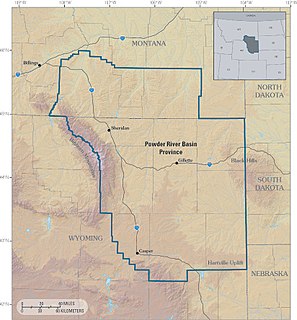
Lignite, often referred to as brown coal, is a soft, brown, combustible, sedimentary rock formed from naturally compressed peat. It is considered the lowest rank of coal due to its relatively low heat content. It has a carbon content around 60–70 percent. It is mined all around the world, is used almost exclusively as a fuel for steam-electric power generation, and is the coal which is most harmful to health.
Southern Company is an American gas and electric utility holding company based in the southern United States. It is headquartered in Atlanta, Georgia, with executive offices also located in Birmingham, Alabama. The company is currently the second largest utility company in the U.S., in terms of customer base. Through its subsidiaries it serves 9 million gas and electric utility customers in nine states. Southern Company's regulated regional electric utilities serve a 120,000-square-mile (310,000 km2) territory with 27,000 miles (43,000 km) of distribution lines.

The Powder River Basin is a geologic structural basin in southeast Montana and northeast Wyoming, about 120 miles (190 km) east to west and 200 miles (320 km) north to south, known for its coal deposits. The region supplies about 40 percent of coal in the United States. It is both a topographic drainage and geologic structural basin. The basin is so named because it is drained by the Powder River, although it is also drained in part by the Cheyenne River, Tongue River, Bighorn River, Little Missouri River, Platte River, and their tributaries.
Coal Creek Station is the largest power plant in the U.S. state of North Dakota. Located near the Missouri River between Underwood, North Dakota and Washburn, North Dakota, it is the largest lignite-fired electricity plant in North Dakota. Its two generators are each rated at 605 megawatts, with a peak total production of nearly 1.2 gigawatts.
The Dakota Gasification Company is a synthetic natural gas producing company founded in 1984 in Beulah, North Dakota, United States. It is an operator of the Great Plains Synfuels Plant. The plant is located at 47°21′27.75″N101°50′28.72″W. The plant uses lignite coal to produce synthetic natural gas utilizing a coal gasification process. The plant processes 16 thousand tons of coal daily. Coal is oxidized to coal gas, which is then converted from a mixture of carbon monoxide, carbon dioxide and hydrogen to methane, by hydrogenation over a nickel catalyst. The synthetic natural gas is pipelined to the Northern Border Pipeline which transports gas from Canada, Montana and North Dakota to the Ventura, Iowa area, where the pipeline interconnects with many pipelines supplying the eastern United States. The Dakota Gasification Company is a subsidiary of the Basin Electric Power Cooperative which is located in Bismarck, North Dakota.
An integrated gasification combined cycle (IGCC) is a technology that uses a high pressure gasifier to turn coal and other carbon based fuels into pressurized gas—synthesis gas (syngas). It can then remove impurities from the syngas prior to the power generation cycle. Some of these pollutants, such as sulfur, can be turned into re-usable byproducts through the Claus process. This results in lower emissions of sulfur dioxide, particulates, mercury, and in some cases carbon dioxide. With additional process equipment, a water-gas shift reaction can increase gasification efficiency and reduce carbon monoxide emissions by converting it to carbon dioxide. The resulting carbon dioxide from the shift reaction can be separated, compressed, and stored through sequestration. Excess heat from the primary combustion and syngas fired generation is then passed to a steam cycle, similar to a combined cycle gas turbine. This process results in improved thermodynamic efficiency compared to conventional pulverized coal combustion.
Clean coal technology is a collection of technologies being developed to attempt to help lessen the environmental impact of coal energy generation and to mitigate worldwide climate change. When coal is used as a fuel source, the gaseous emissions generated by the thermal decomposition of the coal include sulfur dioxide (SO2), nitrogen oxides (NOx), mercury, and other chemical byproducts that vary depending on the type of the coal being used. These emissions have been established to have a negative impact on the environment and human health, contributing to acid rain, lung cancer and cardiovascular disease. As a result, clean coal technologies are being developed to remove or reduce pollutant emissions to the atmosphere. Some of the techniques that would be used to accomplish this include chemically washing minerals and impurities from the coal, gasification (see also IGCC), improved technology for treating flue gases to remove pollutants to increasingly stringent levels and at higher efficiency, carbon capture and storage technologies to capture the carbon dioxide from the flue gas and dewatering lower rank coals (brown coals) to improve the calorific value, and thus the efficiency of the conversion into electricity. Concerns exist regarding the economic viability of these technologies and the timeframe of delivery, potentially high hidden economic costs in terms of social and environmental damage, and the costs and viability of disposing of removed carbon and other toxic matter.
Solid Energy was the largest coal mining company in New Zealand and is a state owned enterprise of the New Zealand Government.
Central Power Electric Cooperative is a North Dakota-based electrical generation and transmission cooperative based in Minot, North Dakota and was founded in 1949. Central Power purchases power from Basin Electric Power Cooperative to serve its six-member rural electric cooperatives. It also built the William J. Neal Station near Voltaire, ND in 1951 to meet its members' needs, with the power being delivered over the lines of the Otter Tail Power Company. Neal Station was sold to Basin when Central Power could become a member of Basin and was later modified to burn sunflower seed hulls in addition to lignite coal. The Neal Station was decommissioned in the early 2000s.

Great River Energy is an electric transmission and generation cooperative in the U.S. state of Minnesota; it is the state's second largest electric utility, based on generating capacity, and the fifth largest generation and transmission cooperative in the U.S. in terms of assets. Great River Energy was formed in 1999 when Cooperative Power Association and United Power Association merged.

Mississippi Power is an investor-owned electric utility and a wholly owned subsidiary of Atlanta-based Southern Company. Mississippi Power Company (MPC) is headquartered in Gulfport, Mississippi.

Coal is mined in every state of Australia. Mining occurs mainly in Queensland, New South Wales and Victoria. About 75% of coal mined in Australia is exported, mostly to eastern Asia, and of the balance most is used in electricity generation. Coal production in Australia increased 13.6% between 2005 and 2010 and 5.3% between 2009 and 2010. In 2016, Australia was the biggest net exporter of coal, with 32% of global exports, and was the fourth-highest producer with 6.9% of global production. 77% of production was exported.

Fossil fuel phase out refers to the discontinuation of the use of fossil fuels, through the decommissioning of operating fossil fuel-fired power plants, the prevention of the construction of new ones, and the use of alternative energy to replace the role of fossil fuels.
MDU Resources Group, Inc. is a U.S.-based corporation supplying essential products and services through its regulated energy delivery and construction materials and services businesses. It is headquartered in Bismarck, North Dakota, and operates in 48 states.
The Monticello Steam Electric Station was a 1.8-gigawatt coal-fired power plant located southwest of Mount Pleasant, Texas in Titus County, Texas. It operated from 1974 to 2018.

The Kemper Project, also called the Kemper County energy facility or Plant Ratcliffe, was a natural gas-fired electrical generating station currently under construction in Kemper County, Mississippi. Mississippi Power, a subsidiary of Southern Company, began construction of the plant in 2010. The initial, coal-fired project was central to President Obama's Climate Plan, as it was to be based on "clean coal" and was being considered for more support from the Congress and the incoming Trump Administration in late 2016. If it had become operational with coal, the Kemper Project would have been a first-of-its-kind electricity plant to employ gasification and carbon capture technologies at this scale.
Coal gasification is a process whereby a hydrocarbon feedstock (coal) is converted into gaseous components by applying heat under pressure in the presence of steam. Rather than burning, most of the carbon-containing feedstock is broken apart by chemical reactions that produce "syngas." Syngas is primarily hydrogen and carbon monoxide, but the exact composition can vary. In Integrated Gasification Combined-Cycle (IGCC) systems, the syngas is cleaned and burned as fuel in a combustion turbine which then drives an electric generator. Exhaust heat from the combustion turbine is recovered and used to create steam for a steam turbine-generator. The use of these two types of turbines in combination is one reason why gasification-based power systems can achieve high power generation efficiencies. Currently, commercially available gasification-based systems can operate at around 40% efficiencies. Syngas, however, emits more greenhouse gases than natural gas, and almost twice as much carbon as a coal plant. Coal gasification is also water-intensive.
Big Brown Power Plant was a 1.15-gigawatt coal power plant located northeast of Fairfield near Fairfield Lake State Park in Freestone County, Texas. It was operated by Vistra Energy, a subsidiary of Luminant. The plant operated from 1971 to 2018.








